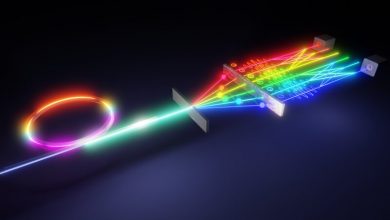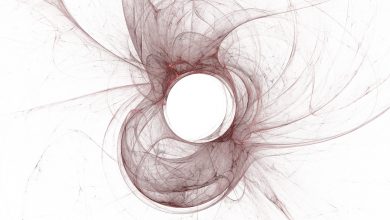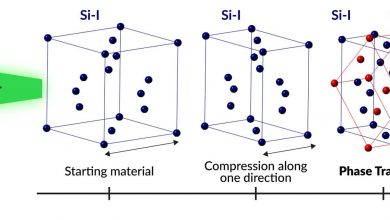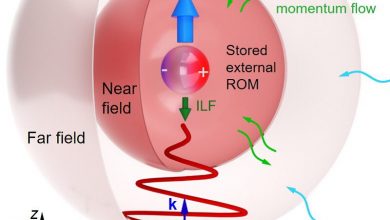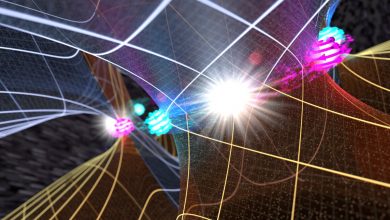Physicists reach qubit computing breakthrough
![a. Experimental SC circuit of device I with qubits and couplers in a square geometry. The light-grey dashed rectangles represent dimers that constitute the chain with intracoupling Ja, intercoupling Je and small cross-coupling Jx. b. Schematic (upper left) of the dynamics of the collective dimer states |Π〉 and |Π′〉. Numerics of the ratio Δ/Γ as a function of system size L for different ratios of Ja/Je, with Jx/2π in the range of [0.3, 1.2] MHz (lower left). Four-dimensional hypercube in the Hilbert space (right). c. Quantum state tomography for the four-qubit fidelity FA(t) and entanglement entropy SA(t) in a 30-qubit chain for thermalizing initial states, namely, |0101…0110〉 (i) and |01001…100110110〉 (ii), and the QMBS state Π′ (green). The couplings are Ja/2π = 1.5Je/2π ≃ −9 MHz. The inset shows the Fourier transform of the four-qubit fidelity with the peak at ω1/2π ≈ 21 MHz. The dashed grey line in the bottom panel represents the maximal thermal entropy for the subsystem, approaching to 4ln(2). d. Same data as c, but for different couplings, namely, Ja/2π = 2.5Je/2π ≃ −10 MHz from device II and ω′1/2π ≈ 22 MHz. Schematics in c and d illustrate the bipartition of the system. Credit: Arizona State University, Zhejiang University Arizona State and Zhejiang Universities reach qubit computing breakthrough](http://peto.info/wp-content/uploads/2022/10/arizona-state-and-zhej-1.jpg)
Researchers from Arizona State University and Zhejiang University in China, along with two theorists from the United Kingdom, have been able to demonstrate for the first time that large numbers of quantum bits, or qubits, can be tuned to interact with each other while maintaining coherence for an unprecedentedly long time, in a programmable, solid state superconducting processor.
Previously, this was only possible in Rydberg atom systems.
In a paper to be published on Thursday, Oct. 13, in Nature Physics, ASU Regents Professor Ying-Cheng Lai, his former ASU doctoral student Lei Ying and experimentalist Haohua Wang, both professors at Zhejiang University in China, have demonstrated a “first look” at the emergence of quantum many-body scarring (QMBS) states as a robust mechanism for maintaining coherence among interacting qubits. Such exotic quantum states offer the appealing possibility of realizing extensive multipartite entanglement for a variety of applications in quantum information science and technology to achieve high processing speed and low power consumption.
“QMBS states possess the intrinsic and generic capability of multipartite entanglement, making them extremely appealing to applications such as quantum sensing and metrology,” explained Ying.
Classical, or binary computing relies on transistors—which can represent only the “1” or the “0” at a single time. In quantum computing, qubits can represent both 0 and 1 simultaneously, which can exponentially accelerate computing processes.
“In quantum information science and technology, it is often necessary to assemble a large number of fundamental information-processing units—qubits—together,” explained Lai. “For applications such as quantum computing, maintaining a high degree of coherence or quantum entanglement among the qubits is essential.
“However, the inevitable interactions among the qubits and environmental noise can ruin the coherence in a very short time—within about ten nanoseconds. This is because many interacting qubits constitute a many-body system,” said Lai.
Key to the research is insight about delaying thermalization to maintain coherence, considered a critical research goal in quantum computing.
“From basic physics, we know that in a system of many interacting particles, for example, molecules in a closed volume, the process of thermalization will arise. The scrambling among many qubits will invariably result in quantum thermalization—the process described by the so-called Eigenstate Thermalization Hypothesis, which will destroy the coherence among the qubits,” said Lai.
According to Lai, the findings moving quantum computing forward will have applications in cryptology, secure communications and cybersecurity, among other technologies.
Conclusion: So above is the Physicists reach qubit computing breakthrough article. Hopefully with this article you can help you in life, always follow and read our good articles on the website: Peto.info
